Generation of Beam Tilt through Three-Dimensional Printed Surface
Abstract
:1. Introduction
2. Unit Cell Analysis and Surface Generation
- Step 1: Note the phase values at /2 distance above the aperture of Horn fed for respective distances of 3.75, 11.25, 18.75, 26.25, 33.75, 41.25, 48.75, 56.25 mm along the aperture positions.
- Step 2: Normalize the noted phase values and choose the values greater than the maximum phase value. The chosen maximum values run through a complete 360 phase cycle.
- Step 3: Generate the five-layer structure of the proposed cubes with eight different rounds that will be able to decrease the overall phase variation along the defined aperture of 16 × 16. Thus, appropriate cubes sizes are selected for defined aperture positions by giving the command from Matlab, which is interlinked with Computer Simulation Technology (CST) software.
- Step 4: Conical Rotating Surface (CRS) is generated for an increasing phase gradient of from the left towards the right direction. These phase values are added to the phase of the eight chosen different rounds from Step 3, which will design the BDS. These surfaces are placed along the E-plane of the feed horn source.
- Step 5: In order to study the beam deflection, BDS is placed above the feed horn source and the angle of rotation is noted for 0, 90, 180 and 270 in the counterclockwise direction.
- Step 6: CRS is rotated in the anticlockwise direction and placed 1 mm above the BDS, which is kept just above the horn aperture. Hence, the broadside directivity and gain are noted along with the side lobe level (SLL) at the design frequency.
- Step 7: Check for SLL whether it is higher than −8 dB. If it is higher, then shift the phase column towards the right direction, which will generate new phase values for CRS and consequently for BDS. Repeat Step 5 until a lower side lobe level of −8 dB is obtained.
- Step 8: Hence, the CRS and BDS are selected that will be able to show a lower side lobe level for broadside conditions where the phase gradient of both surfaces are aligned opposite to each other.
3. Phase Plots for the Generation of CRS and BDS
4. Results and Discussion
4.1. Fabrication of BDS Prototypes
4.2. Radiated Beam Patterns with BDS Surface
5. Conclusions
Author Contributions
Funding
Acknowledgments
Conflicts of Interest
References
- Gu, Y.; Lo, A.; Niemegeers, I. A survey of indoor positioning systems for wireless personal networks. IEEE Commun. Surv. Tutor. 2009, 11, 13–32. [Google Scholar] [CrossRef] [Green Version]
- Fu, X.; Yang, F.; Liu, C.; Wu, X.; Cui, T.J. Terahertz Beam Steering Technologies: From Phased Arrays to Field-Programmable Metasurfaces. Adv. Opt. Mater. 2020, 8, 1900628. [Google Scholar] [CrossRef]
- Ozpinar, H.; Aksimsek, S.; Tokan, N.T. A novel compact, broadband, high gain millimeter-wave antenna for 5G beam steering applications. IEEE Trans. Veh. Technol. 2020, 69, 2389–2397. [Google Scholar] [CrossRef]
- Han, L.; Cheng, G.; Han, G.; Ma, R.; Zhang, W. Electronically beam-steering antenna with active frequency-selective surface. IEEE Antennas Wirel. Propag. Lett. 2018, 18, 108–112. [Google Scholar] [CrossRef]
- Akbari, M.; Farahani, M.; Ghayekhloo, A.; Zarbakhsh, S.; Sebak, A.R.; Denidni, T.A. Beam Tilting Approaches Based on Phase Gradient Surface for mmWave Antennas. IEEE Trans. Antennas Propag. 2020, 68, 4372–4385. [Google Scholar] [CrossRef]
- Balanis, C.A. Antenna Theory: Analysis and Design; John Wiley & Sons: Hoboken, NJ, USA, 2016. [Google Scholar]
- Uchendu, I.; Kelly, J.R. Survey of beam steering techniques available for millimeter wave applications. Prog. Electromagn. Res. 2016, 68, 35–54. [Google Scholar] [CrossRef] [Green Version]
- Ma, H.F.; Cui, T.J. Three-dimensional broadband and broad-angle transformation-optics lens. Nat. Commun. 2010, 1, 1–7. [Google Scholar]
- Yi, J.; Burokur, S.N.; de Lustrac, A. Experimental validation of a transformation optics based lens for beam steering. Appl. Phys. Lett. 2015, 107, 154101. [Google Scholar] [CrossRef]
- Foster, R.; Nagarkoti, D.; Gao, J.; Vial, B.; Nicholls, F.; Spooner, C.; Haq, S.; Hao, Y. Beam-steering performance of flat Luneburg lens at 60 GHz for future wireless communications. Int. J. Antennas Propag. 2017, 2017, 7932434. [Google Scholar] [CrossRef] [Green Version]
- Jia, D.; He, Y.; Ding, N.; Zhou, J.; Du, B.; Zhang, W. Beam-steering flat lens antenna based on multilayer gradient index metamaterials. IEEE Antennas Wirel. Propag. Lett. 2018, 17, 1510–1514. [Google Scholar] [CrossRef]
- Mateo-Segura, C.; Dyke, A.; Dyke, H.; Haq, S.; Hao, Y. Flat Luneburg lens via transformation optics for directive antenna applications. IEEE Trans. Antennas Propag. 2014, 62, 1945–1953. [Google Scholar] [CrossRef]
- Nicholls, J.G.; Hum, S.V. Full-space electronic beam-steering transmitarray with integrated leaky-wave feed. IEEE Trans. Antennas Propag. 2016, 64, 3410–3422. [Google Scholar] [CrossRef]
- Vilenskiy, A.R.; Makurin, M.N.; Lee, C.; Ivashina, M.V. Reconfigurable Transmitarray With Near-Field Coupling to Gap Waveguide Array Antenna for Efficient 2-D Beam Steering. IEEE Trans. Antennas Propag. 2020, 68, 7854–7865. [Google Scholar] [CrossRef]
- Massaccesi, A.; Dassano, G.; Pirinoli, P. Beam scanning capabilities of a 3d-printed perforated dielectric transmitarray. Electronics 2019, 8, 379. [Google Scholar] [CrossRef] [Green Version]
- Abbasi, M.I.; Dahri, M.H.; Jamaluddin, M.H.; Seman, N.; Kamarudin, M.R.; Sulaiman, N.H. Millimeter wave beam steering reflectarray antenna based on mechanical rotation of array. IEEE Access 2019, 7, 145685–145691. [Google Scholar] [CrossRef]
- Nayeri, P.; Liang, M.; Sabory-Garcı, R.A.; Tuo, M.; Yang, F.; Gehm, M.; Xin, H.; Elsherbeni, A.Z. 3D printed dielectric reflectarrays: Low-cost high-gain antennas at sub-millimeter waves. IEEE Trans. Antennas Propag. 2014, 62, 2000–2008. [Google Scholar] [CrossRef]
- Da Wu, M.; Li, B.; Zhou, Y.; Liu, Y.; Wei, F.; Lv, X. Design and measurement of a 220 GHz wideband 3-D printed dielectric reflectarray. IEEE Antennas Wirel. Propag. Lett. 2018, 17, 2094–2098. [Google Scholar]
- Katare, K.K.; Chandravanshi, S.; Biswas, A.; Akhtar, M.J. A compact configuration of semicircular metasurface loaded slot antenna for beam steering application. Int. J. RF Microw. Comput. Aided Eng. 2019, 29, e21526. [Google Scholar] [CrossRef]
- Naqvi, A.H.; Lim, S. A beam-steering antenna with a fluidically programmable metasurface. IEEE Trans. Antennas Propag. 2019, 67, 3704–3711. [Google Scholar] [CrossRef]
- Bazaz, S.R.; Rouhi, O.; Raoufi, M.A.; Ejeian, F.; Asadnia, M.; Jin, D.; Warkiani, M.E. 3D printing of inertial microfluidic devices. Sci. Rep. 2020, 10, 1–14. [Google Scholar]
- Bazaz, S.R.; Mehrizi, A.A.; Ghorbani, S.; Vasilescu, S.; Asadnia, M.; Warkiani, M.E. A hybrid micromixer with planar mixing units. RSC Adv. 2018, 8, 33103–33120. [Google Scholar] [CrossRef] [Green Version]
- Cairone, F.; Gagliano, S.; Carbone, D.C.; Recca, G.; Bucolo, M. Micro-optofluidic switch realized by 3D printing technology. Microfluid. Nanofluid. 2016, 20, 61. [Google Scholar] [CrossRef]
- Afzal, M.U.; Matekovits, L.; Esselle, K.P.; Lalbakhsh, A. Beam-Scanning Antenna Based on Near-Electric Field Phase Transformation and Refraction of Electromagnetic Wave Through Dielectric Structures. IEEE Access 2020, 8, 199242–199253. [Google Scholar] [CrossRef]
- Afzal, M.U.; Esselle, K.P. Steering the beam of medium-to-high gain antennas using near-field phase transformation. IEEE Trans. Antennas Propag. 2017, 65, 1680–1690. [Google Scholar] [CrossRef]
- Baba, A.A.; Hashmi, R.M.; Esselle, K.P.; Attygalle, M.; Borg, D. A millimeter-wave antenna system for wideband 2-D beam steering. IEEE Trans. Antennas Propag. 2020, 68, 3453–3464. [Google Scholar] [CrossRef]
- Zhao, X.; Yuan, C.; Liu, L.; Peng, S.; Zhang, Q.; Yu, L.; Sun, Y. All-metal beam steering lens antenna for high power microwave applications. IEEE Trans. Antennas Propag. 2017, 65, 7340–7344. [Google Scholar] [CrossRef]
- Han, J.; Li, L.; Zhang, T.; Xi, R. Control and improvement of antenna gain by using multilayer non-uniform metasurfaces. EPJ Appl. Metamater. 2019, 6, 4. [Google Scholar] [CrossRef]
- Shrestha, S.; Zahra, H.; Abbasi, M.A.B.; Asadnia, M.; Abbas, S.M. Increasing the directivity of resonant cavity antennas with nearfield transformation meta-structure realized with stereolithograpy. Electronics 2021, 10, 333. [Google Scholar] [CrossRef]
- Shrestha, S.; Mohamadzade, B.; Baba, A.A.; Hashmi, R.M. 3D Printable Phase Transformation Meta-Structure for Resonant Cavity Antennas. In Proceedings of the 2020 International Conference on UK-China Emerging Technologies (UCET), Glasgow, UK, 20–21 August 2020; pp. 1–3. [Google Scholar]
- Shrestha, S.; Baba, A.A.; Abbas, S.M.; Asadnia, M.; Hashmi, R.M. A Horn Antenna Covered with a 3D-Printed Metasurface for Gain Enhancement. Electronics 2021, 10, 119. [Google Scholar] [CrossRef]
- Shrestha, S.; Mohamadzade, B.; Baba, A.A.; Hashmi, R.M. Effect of Unit Cell Arrangements in Near Field Transformation Lattice on Aperture Efficiency of Resonant Cavity Antenna. In Proceedings of the 2019 International Conference on Electromagnetics in Advanced Applications (ICEAA), Cartagena de Indias, Colombia, 10–14 September 2019; pp. 370–371. [Google Scholar]
- Shrestha, S.; Baba, A.A.; Abbas, S.M.; Asadnia, M.; Hashmi, R.M. A Multi-Layer Partially Reflecting Surface Antenna for Cost-Effective 3D Printing manufacturing. In Proceedings of the 2020 IEEE International Symposium on Antennas and Propagation and North American Radio Science Meeting, Montreal, QC, Canada, 4–11 June 2020; pp. 1485–1486. [Google Scholar]
- Reis, J.R.; Vala, M.; Caldeirinha, R.F. Review paper on transmitarray antennas. IEEE Access 2019, 7, 94171–94188. [Google Scholar] [CrossRef]
- Frigyes, I.; Seeds, A. Optically generated true-time delay in phased-array antennas. IEEE Trans. Microw. Theory Tech. 1995, 43, 2378–2386. [Google Scholar] [CrossRef]
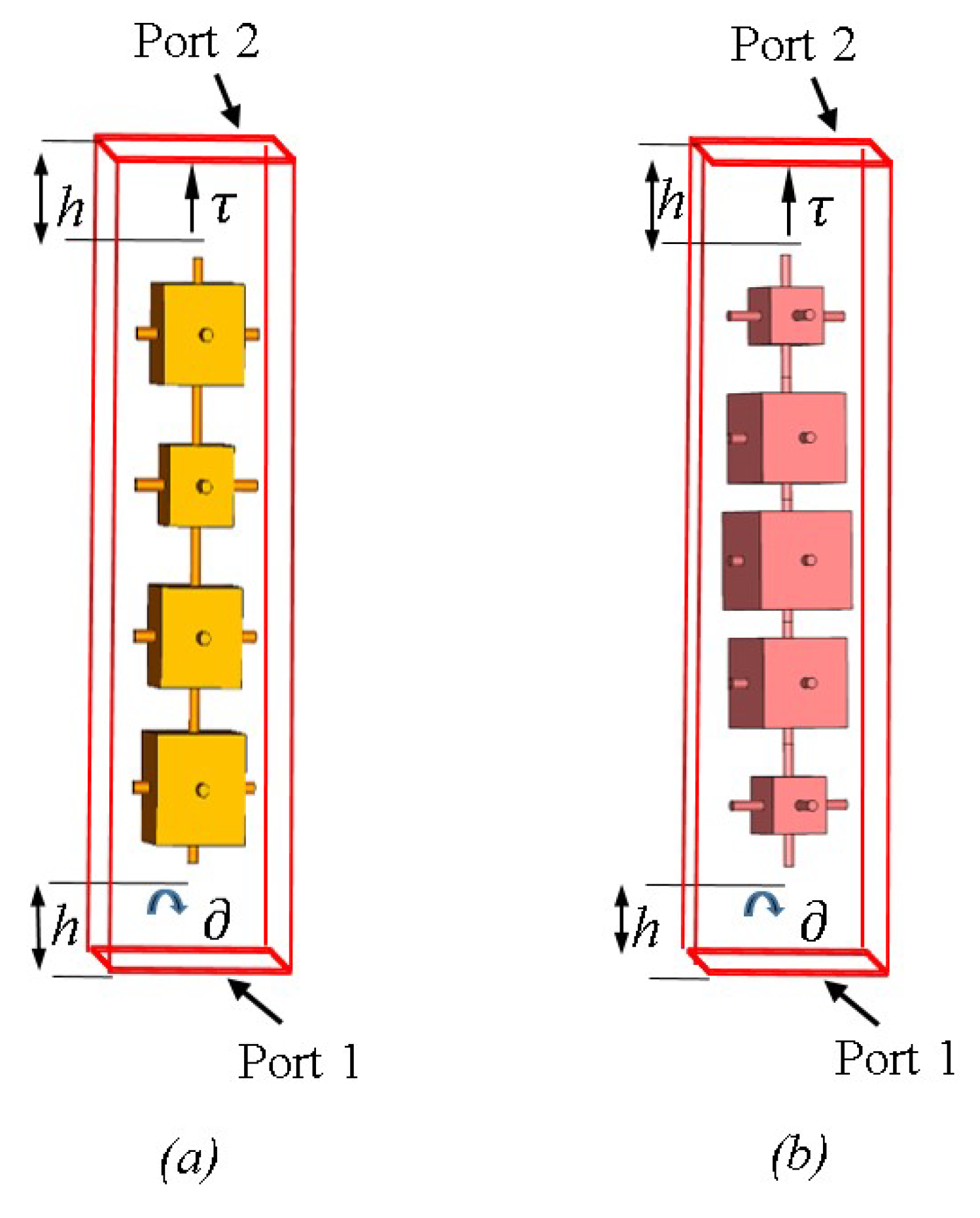
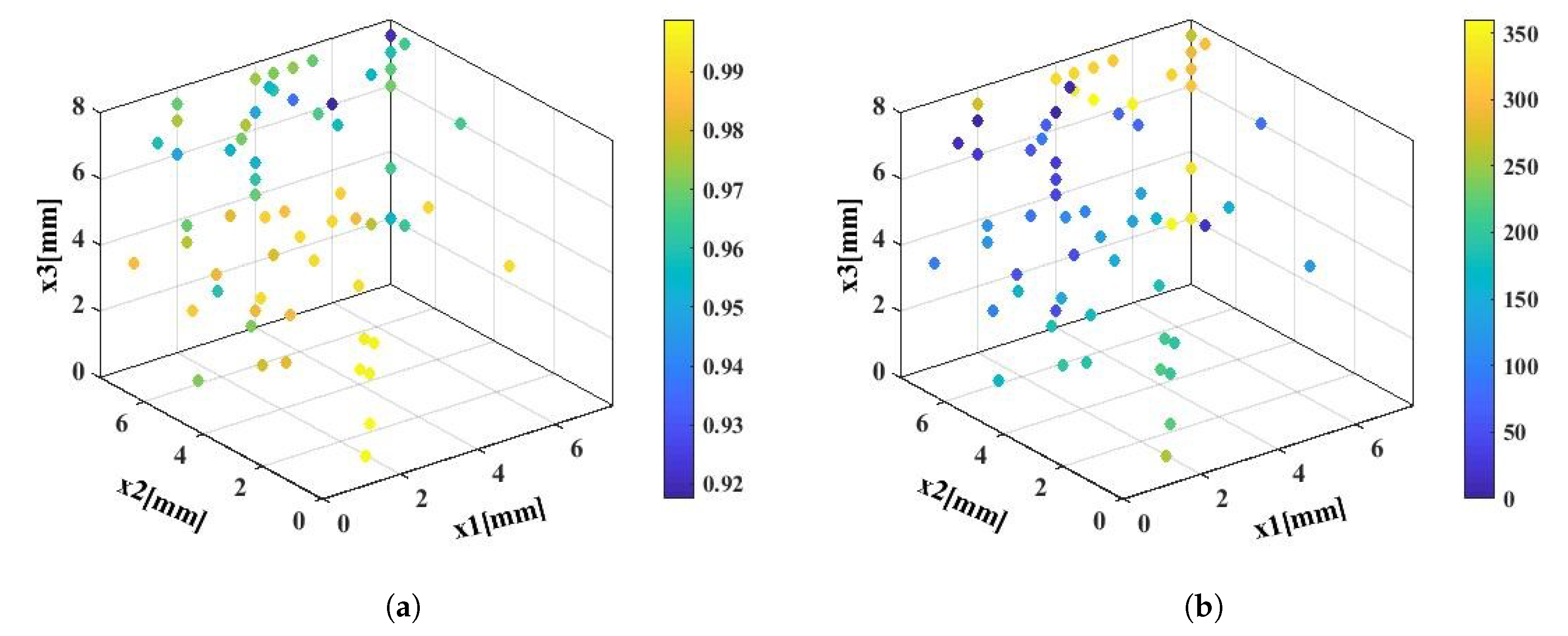
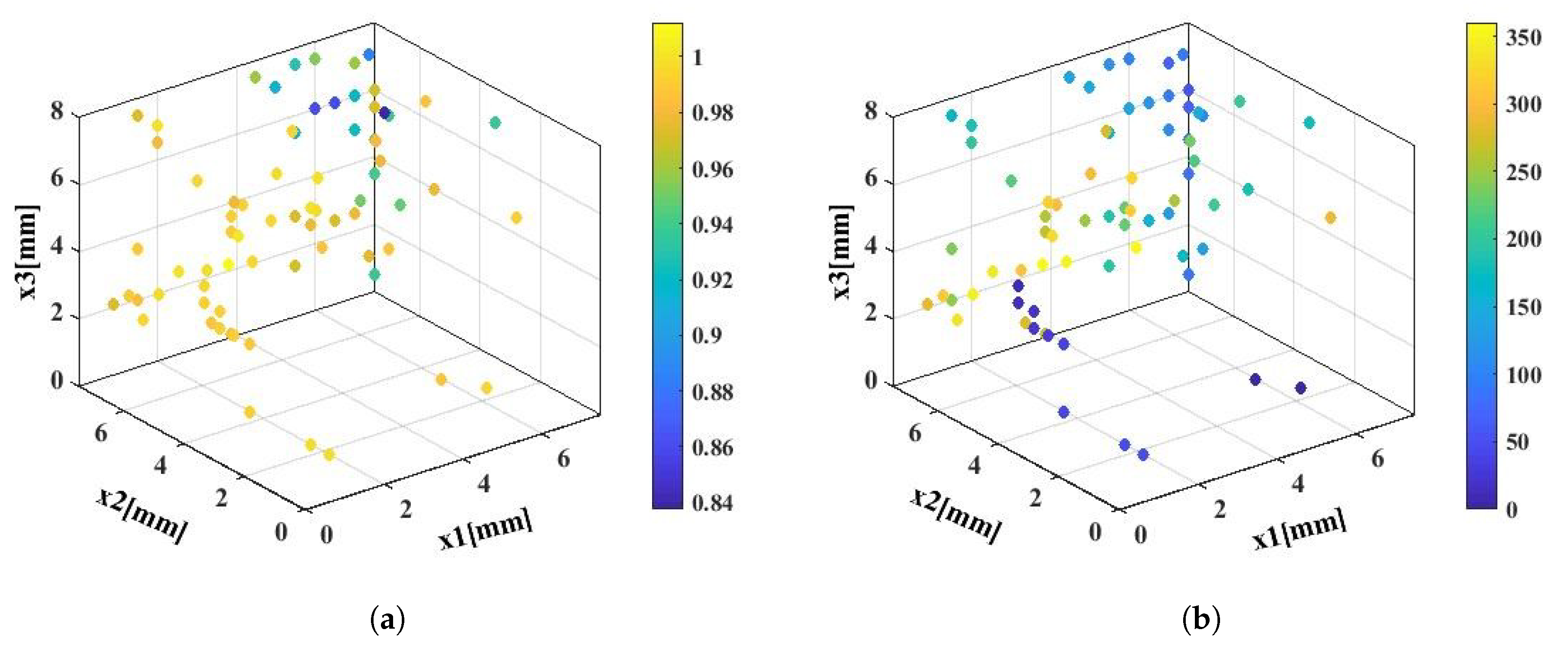
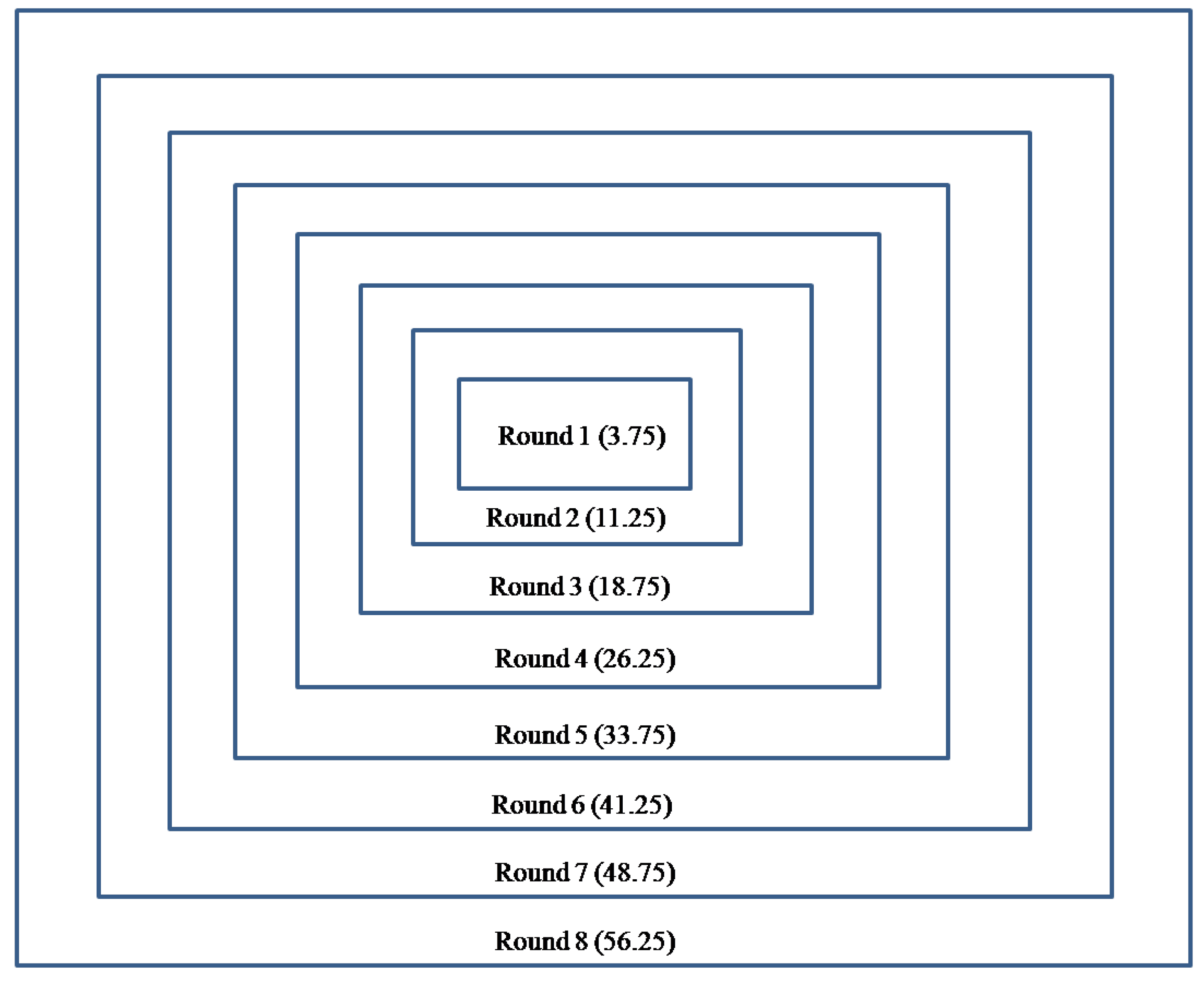
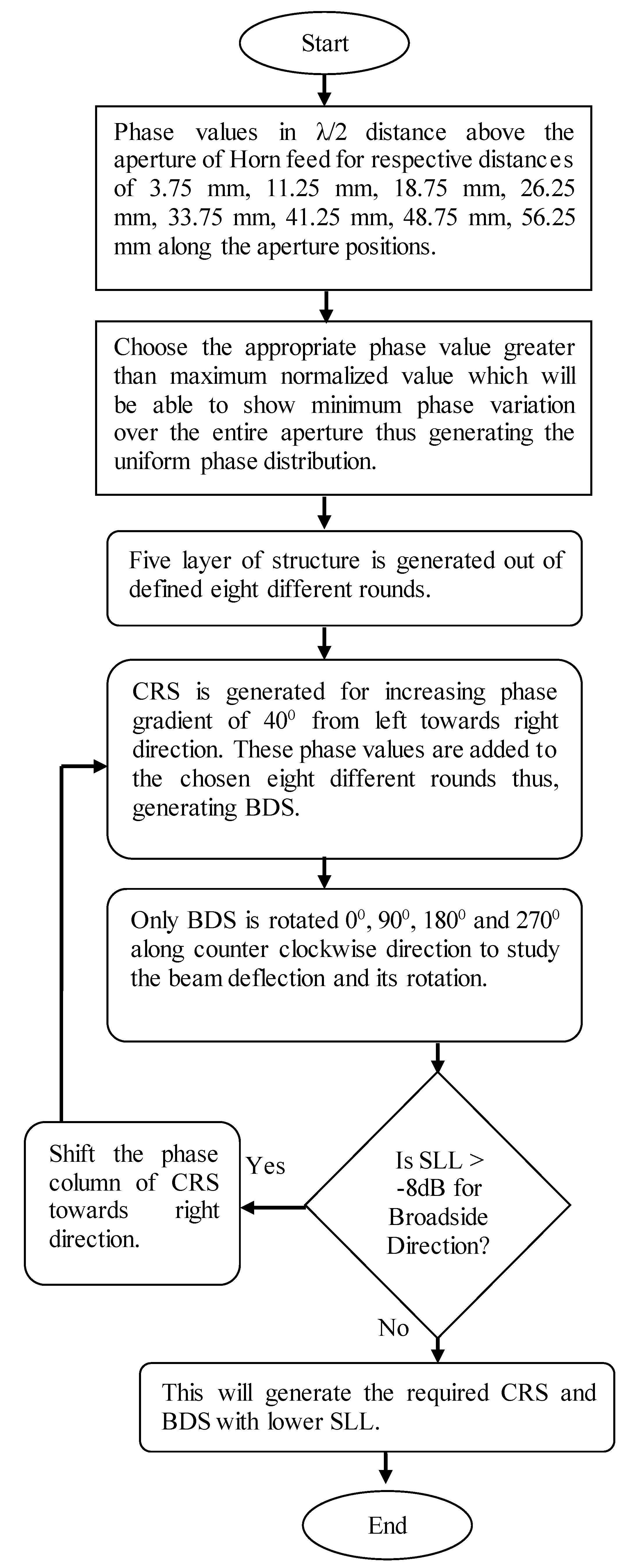
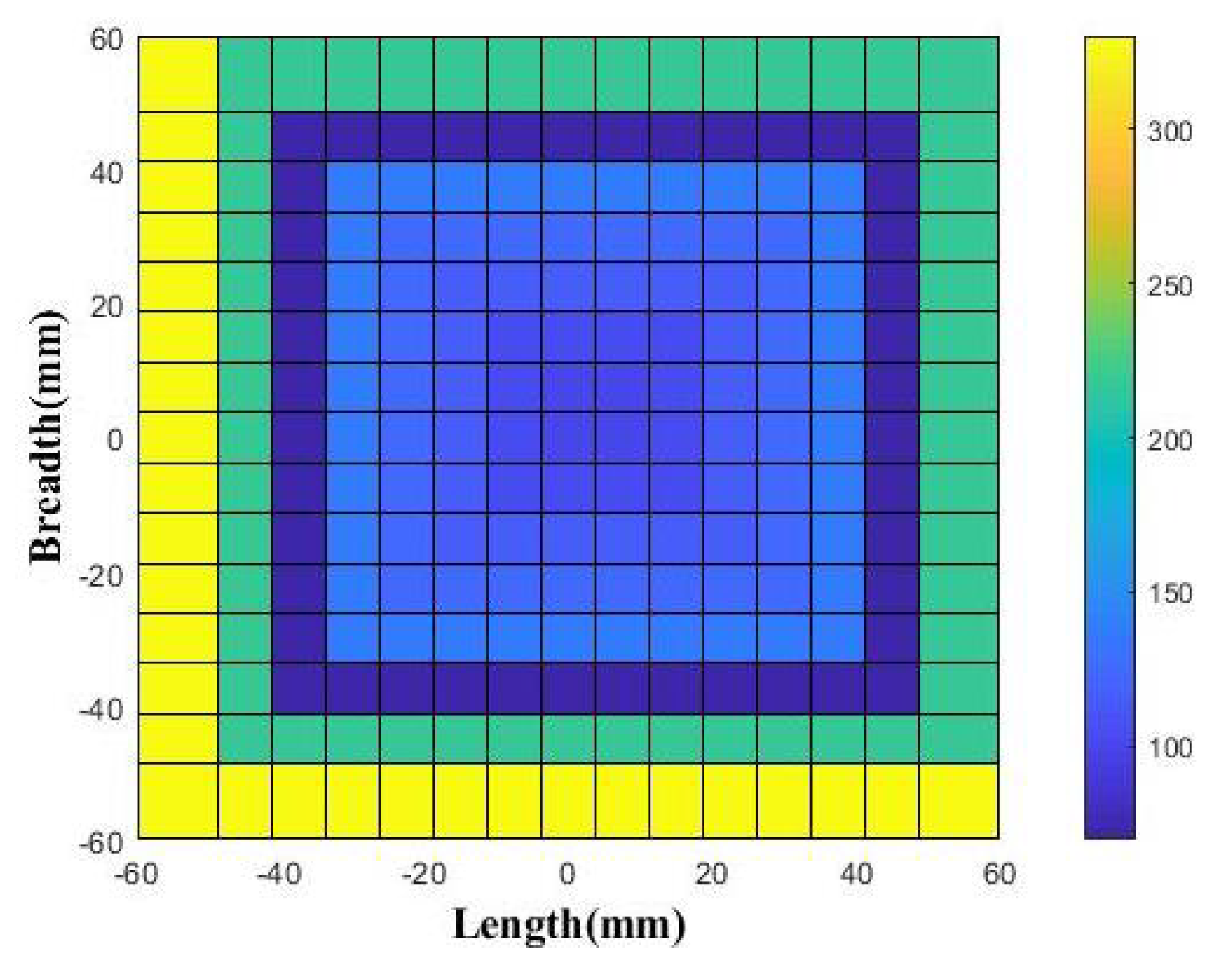
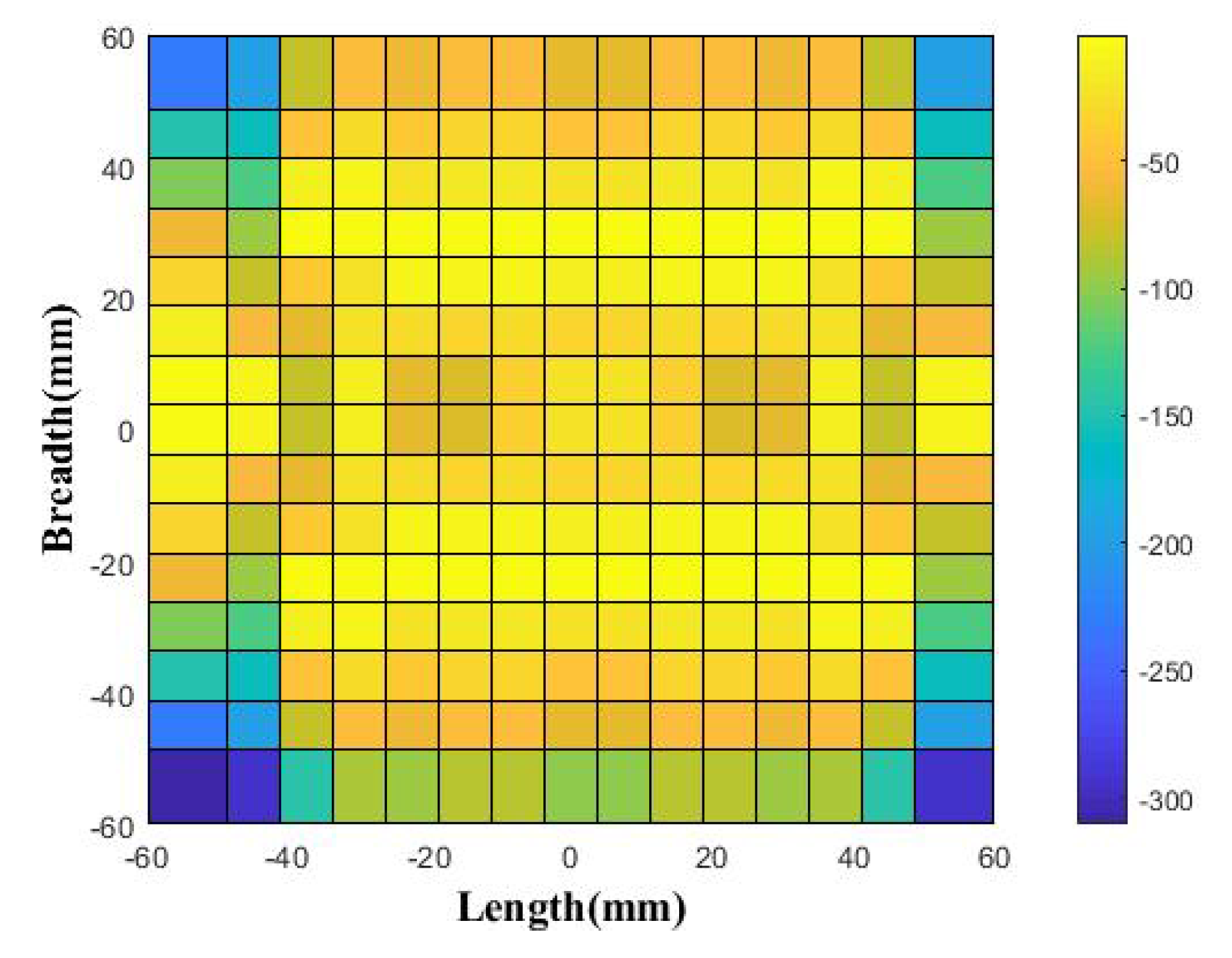
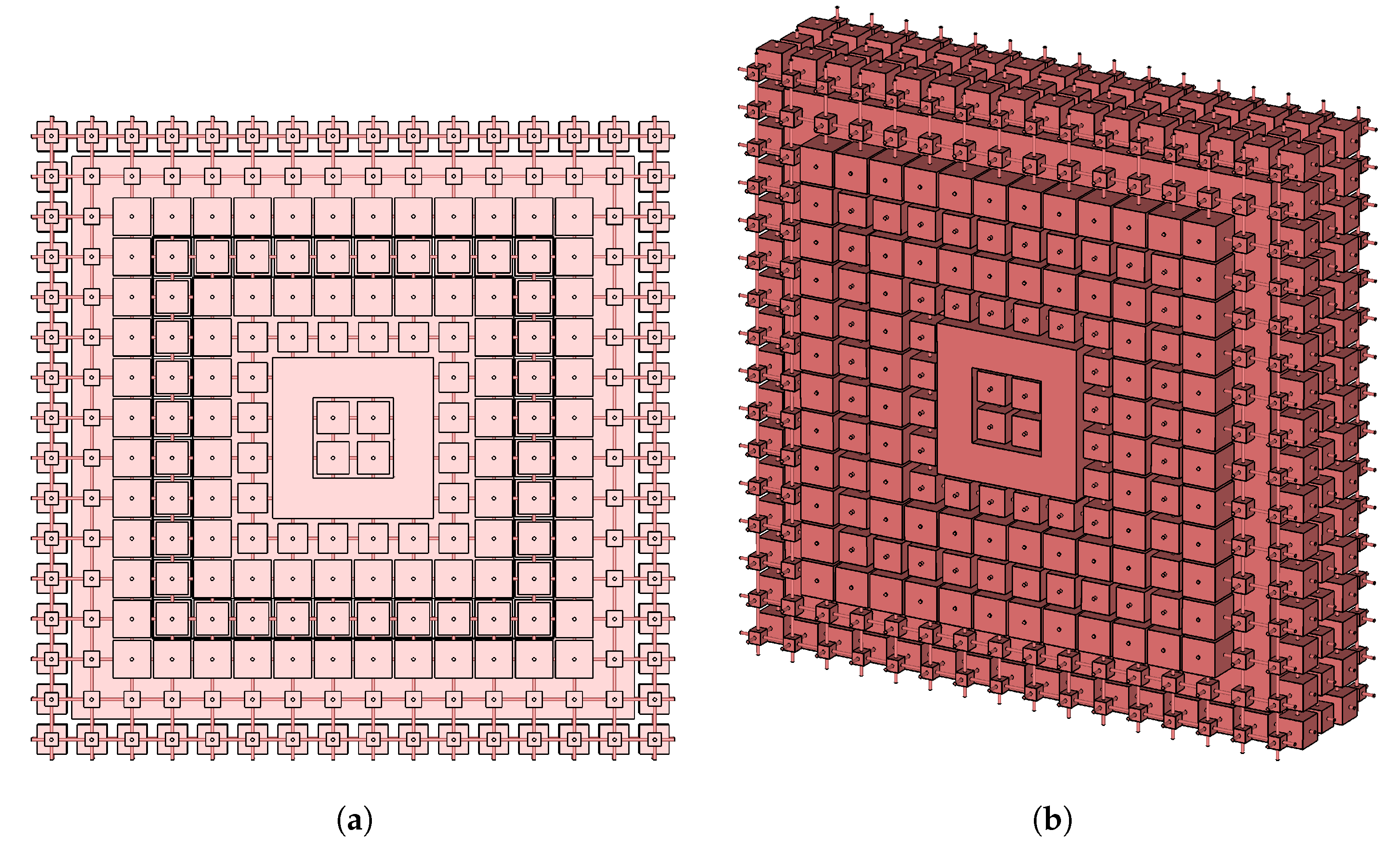

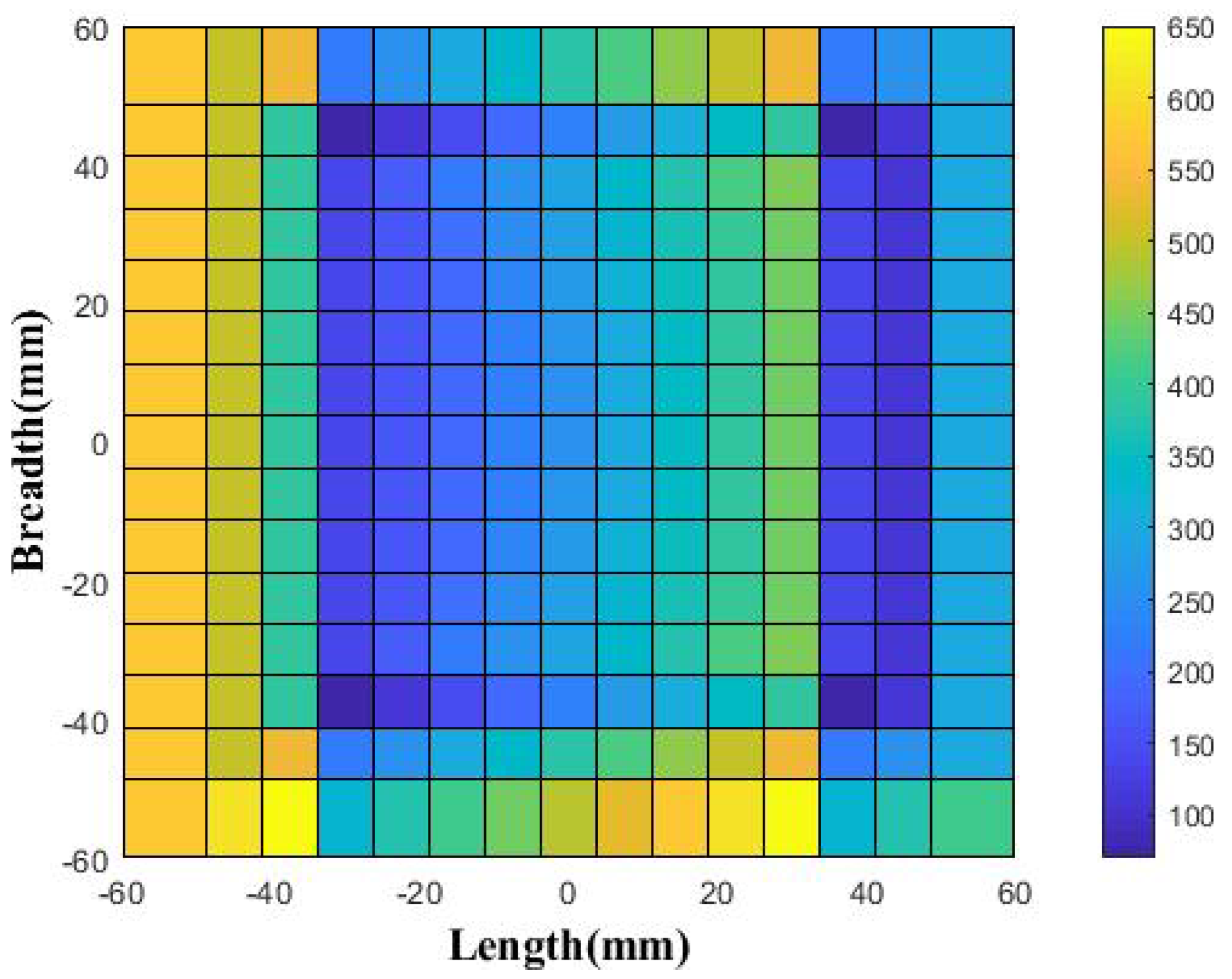
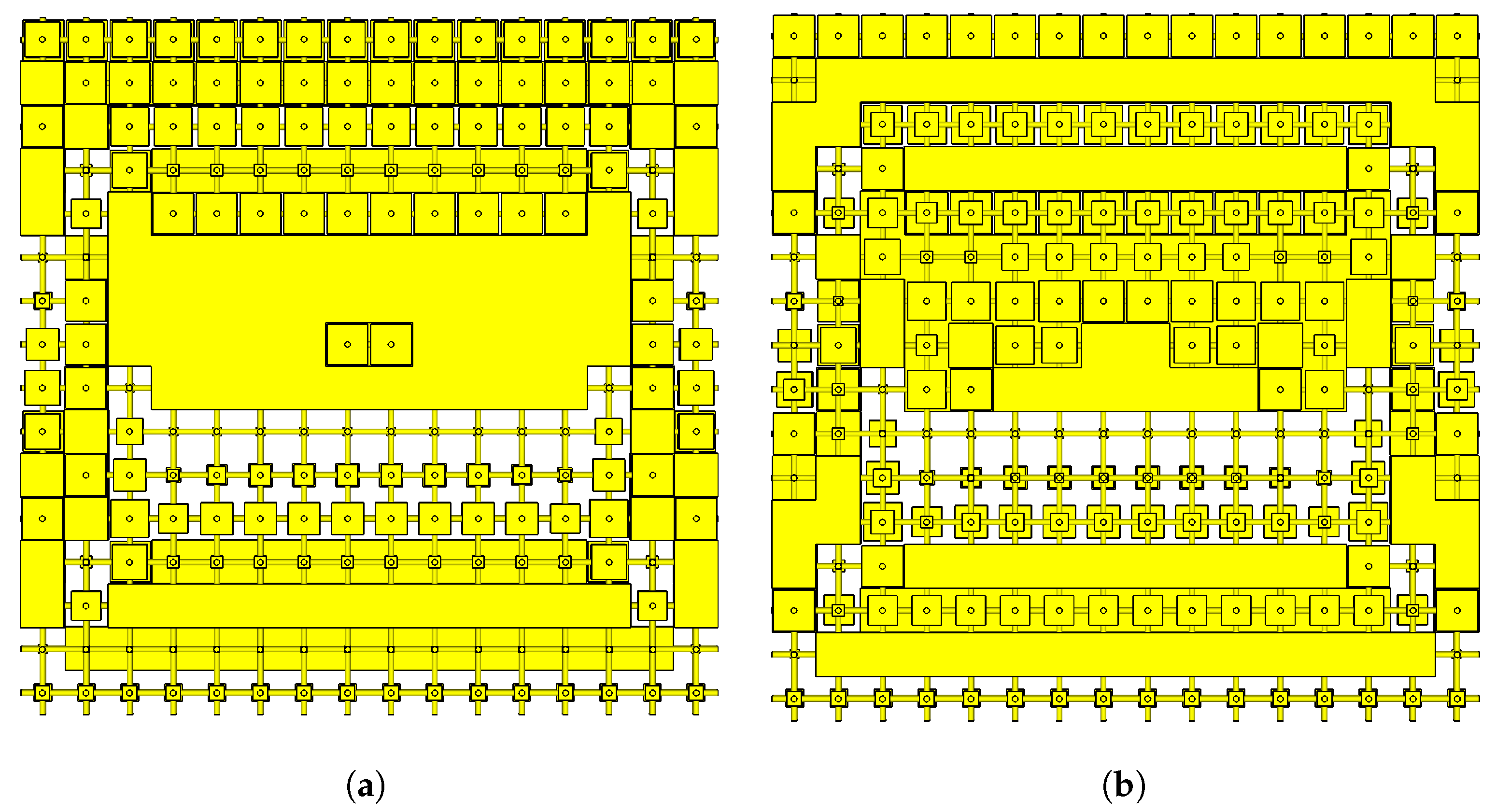


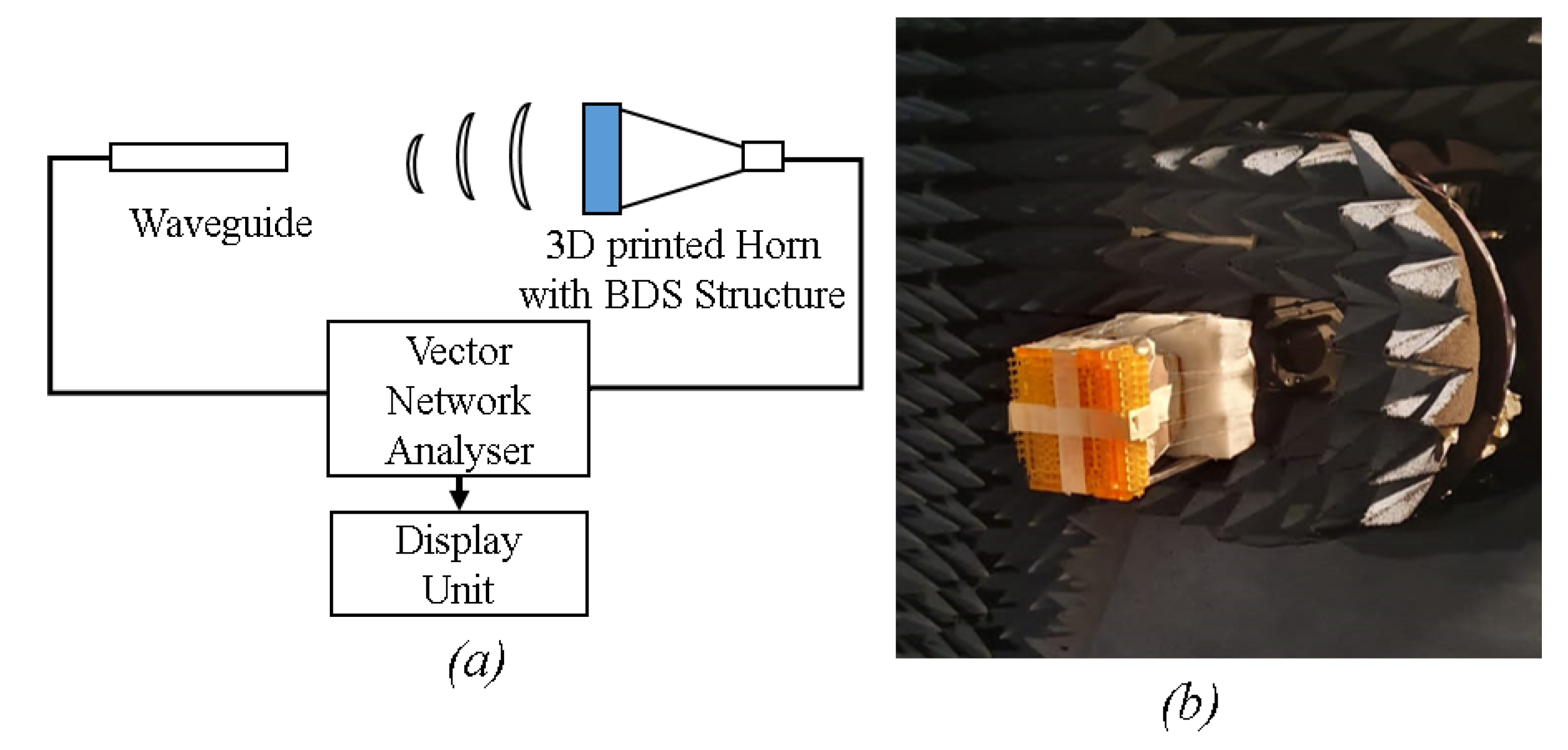
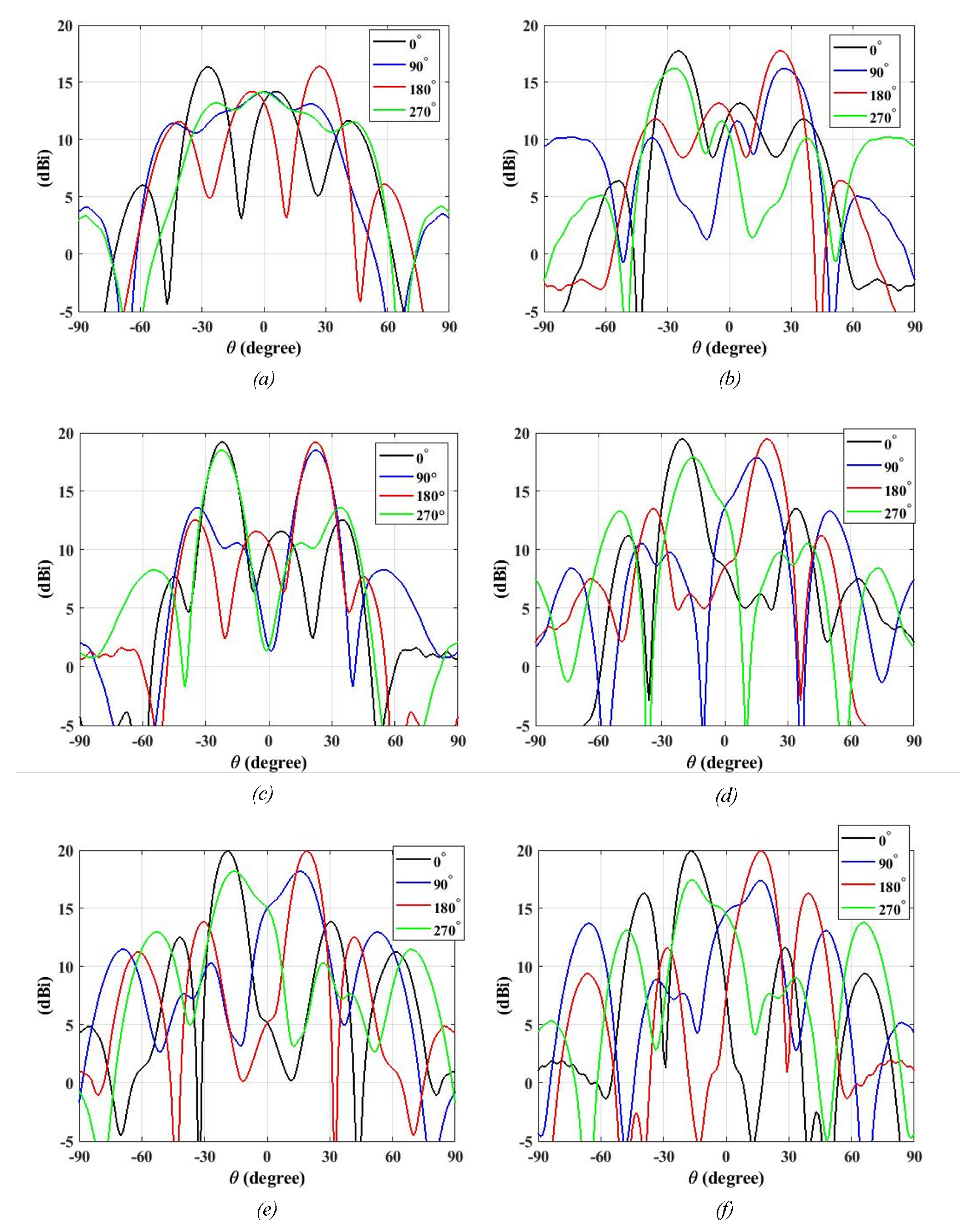
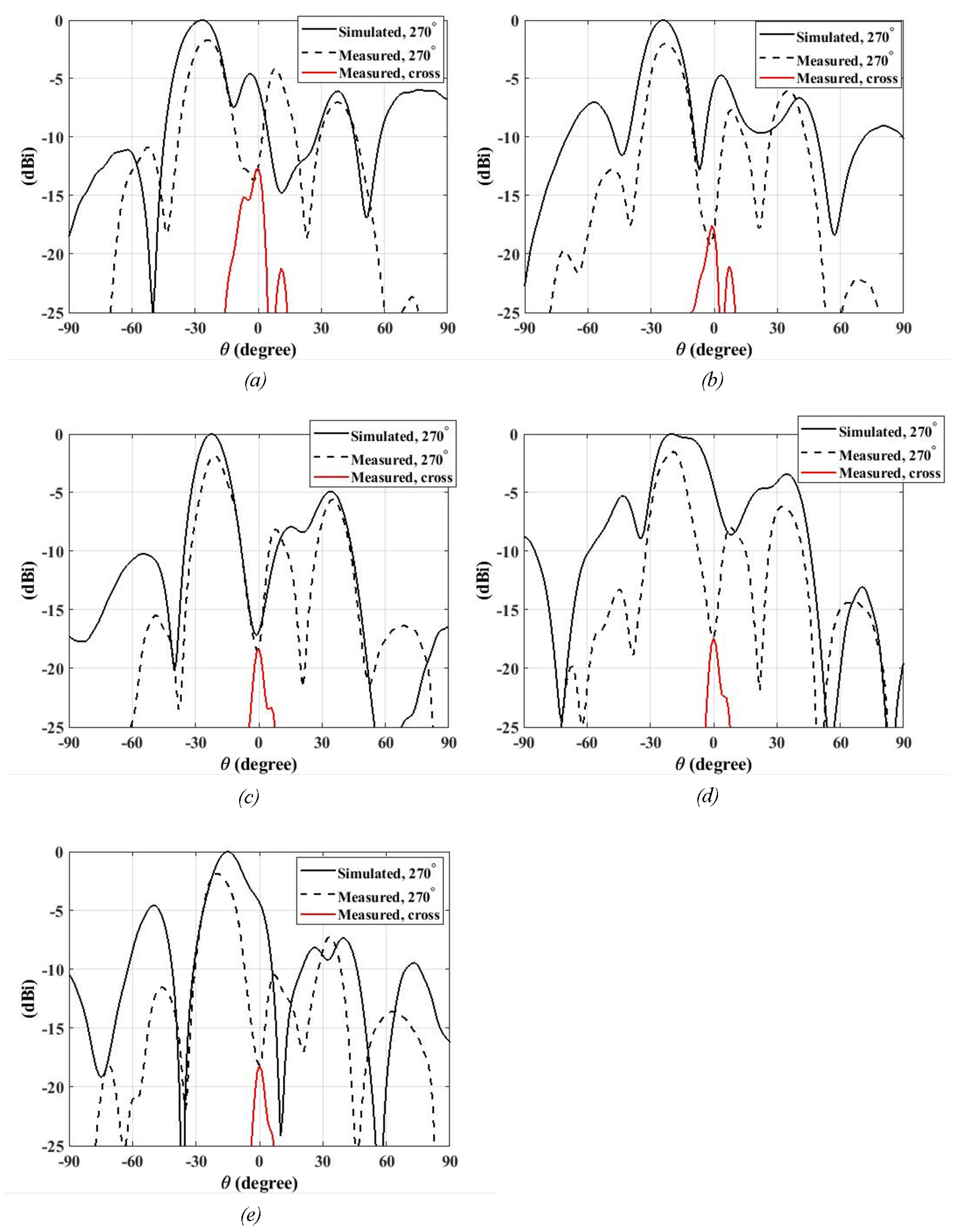
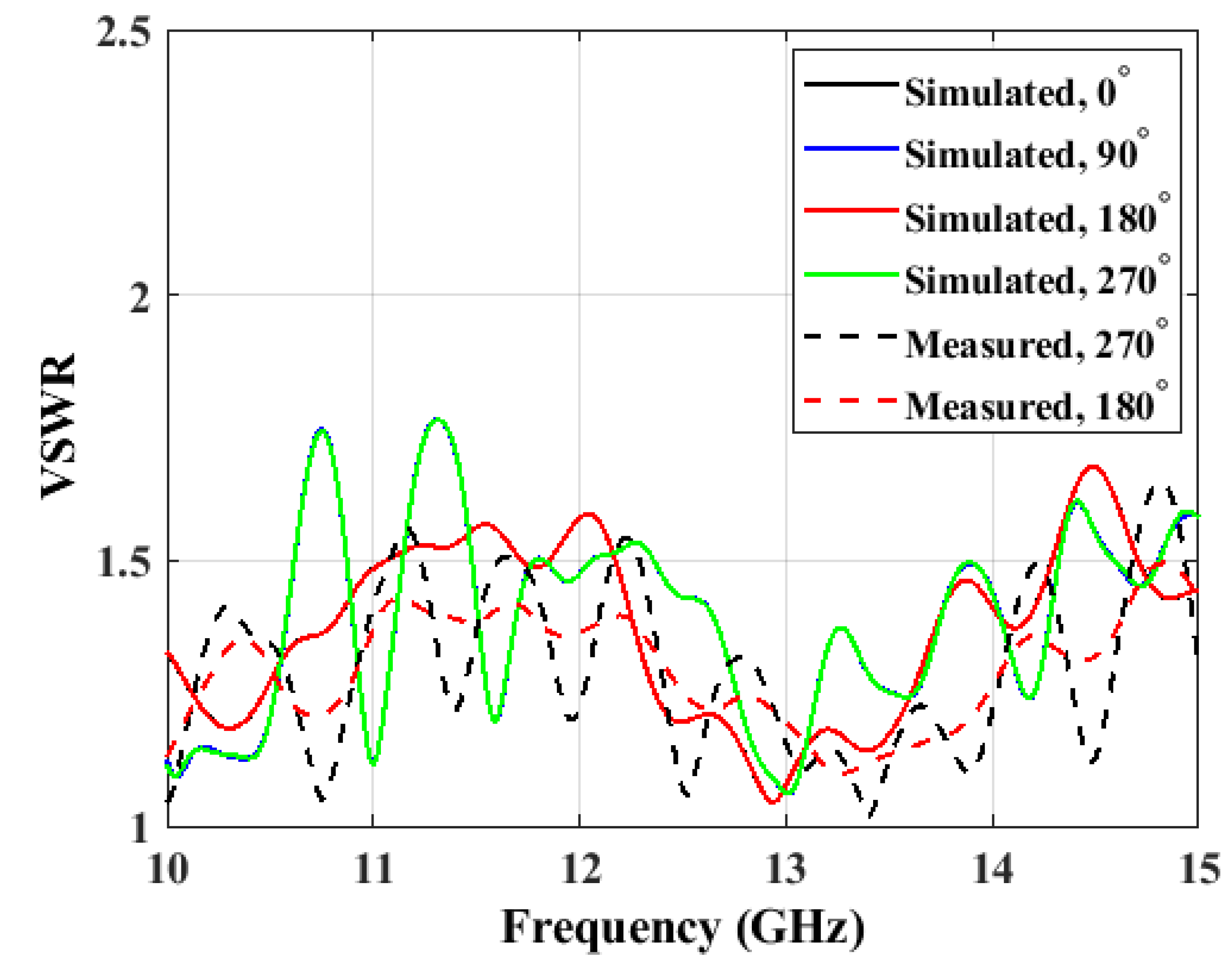
| Ref. | Operating Band Width (GHz) | Electrical Area (mm × mm) | Electrical Height from Feed (mm) | Lowest Operating Frequency (GHz) | Operating Frequency (GHz) | Peak Gain (dBi) | Band Width (%) | 3 dB Band Width (%) | Beam Tilt Angle () | Feed Source | Thickness of Substrate (mm) | Aperture Size | Fabrication Technique |
|---|---|---|---|---|---|---|---|---|---|---|---|---|---|
| [24] | 29.2 to 30.8 | 11.2 × 11.2 (112 × 112) | 10 | 29.2 | 30 | 16.2 | 5.3 | 2.7 | 39 | RCA | 6.9 (69.3) | 11.2 × 11.2 × 6.9 | FDM |
| [25] | n/a | 6 × 6 (62 × 62) | 13.64 | 11 | 11 | 19.4 | n/a | n/a | 51 | Patch Antenna | 0.92 (24.88) | 6 × 6 × 0.92 | Patches |
| [26] | 26.5 to 40 | 7.07 × 2.25 (60.58 × 19.28) | 4.29 | 26.5 | 35 | 21.7 | 40.6 | 20.3 | 40 | WR-28 Horn | 4.43 (38) | 7.07 × 2.25 × 4.43 | CNC |
| [27] | 9.275 to 9.475 | 7.97 × 7.97 (255.2 × 255.2) | 20 | 9.275 | 9.375 | n/a | 2.1 | 1.2 | 10 | Horn | 3.12 (100) | 7.97 × 7.97 × 3.12 | Metal |
| [28] | 9.2 to 10.6 | 6.67 × 6.67 (200 × 200) | 100 | 9.2 | 10 | 23.75 | 14 | 7.07 | 30 | Horn | 0.2 (6) | 6.67 × 6.67 × 0.2 | Patches |
| Prop. | 10 to 15 | 4.8 × 4.8 (120 × 120) | No Gap | 10 | 12 | 18.5 | 50 | 20 | 22.5 | 3D Printed Horn | 1.2 (30) | 4.8 × 4.8 × 1.2 | Multijet 3D Printing |
Publisher’s Note: MDPI stays neutral with regard to jurisdictional claims in published maps and institutional affiliations. |
© 2021 by the authors. Licensee MDPI, Basel, Switzerland. This article is an open access article distributed under the terms and conditions of the Creative Commons Attribution (CC BY) license (https://creativecommons.org/licenses/by/4.0/).
Share and Cite
Shrestha, S.; Zahra, H.; Abbas, S.M.; Kiyani, A.; Mohamadzade, B.; Asadnia, M. Generation of Beam Tilt through Three-Dimensional Printed Surface. Electronics 2021, 10, 3174. https://doi.org/10.3390/electronics10243174
Shrestha S, Zahra H, Abbas SM, Kiyani A, Mohamadzade B, Asadnia M. Generation of Beam Tilt through Three-Dimensional Printed Surface. Electronics. 2021; 10(24):3174. https://doi.org/10.3390/electronics10243174
Chicago/Turabian StyleShrestha, Sujan, Hijab Zahra, Syed Muzahir Abbas, Arslan Kiyani, Bahare Mohamadzade, and Mohsen Asadnia. 2021. "Generation of Beam Tilt through Three-Dimensional Printed Surface" Electronics 10, no. 24: 3174. https://doi.org/10.3390/electronics10243174
APA StyleShrestha, S., Zahra, H., Abbas, S. M., Kiyani, A., Mohamadzade, B., & Asadnia, M. (2021). Generation of Beam Tilt through Three-Dimensional Printed Surface. Electronics, 10(24), 3174. https://doi.org/10.3390/electronics10243174








